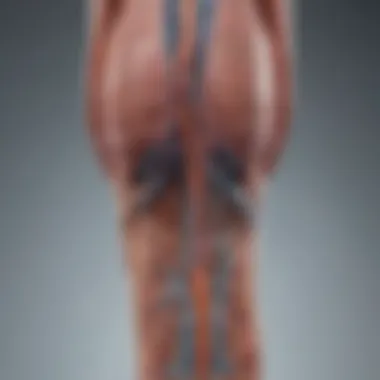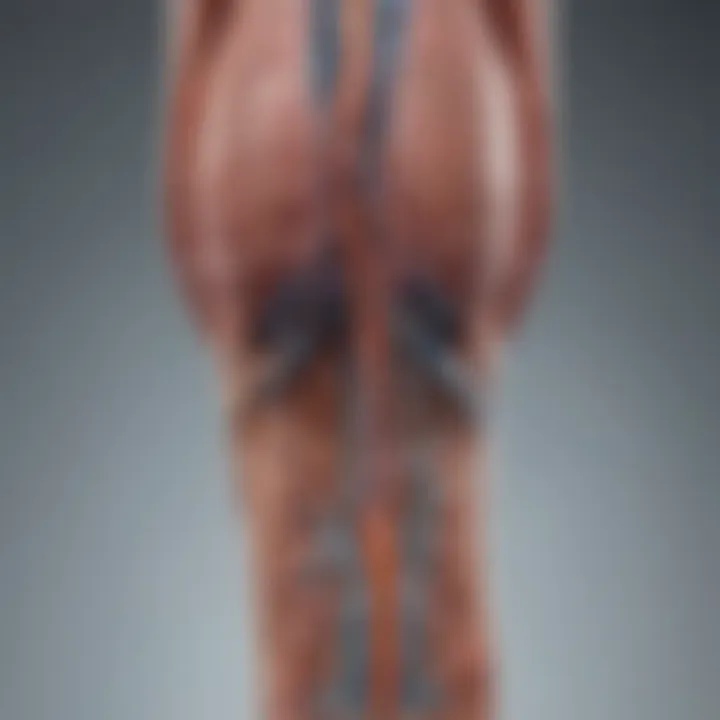Neurological Disorders and the Risk of Falling


Intro
Falling is often perceived as a common concern, particularly among the elderly. However, the linkage between neurological disorders and falling risk remains an area that warrants closer examination. Neurological conditions can severely affect balance, coordination, and overall mobility. Recognizing these associations is crucial for reducing fall rates and enhancing safety. This article aims to illuminate the various neurological disorders that contribute to falling, outlining the mechanisms at play along with practical applications in patient care.
Article Overview
Purpose of the Article
This article serves to delve into the complexities of neurological disorders that lead to falling. By exploring the intricate relationship between these disorders and their impact on motor functions, the text will provide valuable insights that can inform clinical practice. The aim is to provide healthcare professionals, caregivers, and researchers with comprehensive knowledge to design effective intervention strategies.
Relevance to Multiple Disciplines
Understanding the connection between neurological disorders and falls extends beyond neurology; it touches on geriatrics, rehabilitation, physiotherapy, and occupational health fields. Each discipline brings a unique perspective, contributing to a holistic view of patient safety.
Research Background
Historical Context
The study of falls and their relation to neurological disorders has evolved over the decades. Initial investigations primarily focused on age-related vulnerability, yet recent research underscores the significance of specific neurological impairments. Progress in technology and methodologies has enhanced the ability to assess the mechanisms behind falls.
Key Concepts and Definitions
Understanding key terms is vital when discussing neurological disorders and their impact on falling.
- Neurological Disorders: Medical conditions that primarily affect the nervous system, which includes disorders such as Parkinson's disease, multiple sclerosis, and stroke.
- Balance: The ability to maintain the body's center of gravity within its base of support, influenced by neurological function.
- Fall Risk: The likelihood of a person falling, often assessed through various clinical tools.
These concepts form the foundation for examining how various disorders contribute to falls, allowing for targeted interventions and better patient outcomes.
Prelude
Falls represent a significant health risk, especially among individuals suffering from various neurological disorders. This article seeks to illuminate the intricate relationship between these disorders and the increased likelihood of falling. Understanding this connection is essential for healthcare professionals as well as caregivers and researchers. Such awareness enables the development of targeted intervention strategies to mitigate the risks associated with falling and ultimately enhance safety for affected individuals.
Neurological disorders often compromise balance, cognitive function, and physical strength, contributing to instability. Conditions such as Parkinson’s Disease, Multiple Sclerosis, and Stroke are notable examples where the risk of falls is markedly heightened. This article will delve into each of these disorders in detail, analyzing their specific contributions to fall risks.
Effective management and preventive measures are paramount in reducing falls among patients. Therefore, this overview encompasses not only the disorders themselves but also their mechanisms, clinical assessments, and management strategies. By equipping healthcare workers with comprehensive insights, we aim to improve patient outcomes and reduce the incidence of falls.
With the burden of falls largely falling on healthcare systems and families alike, the implications of this knowledge cannot be overstated. Tailored approaches can not only improve individual safety but also reduce associated healthcare costs.
"Understanding neurological disorders and their relation to falls is not just academic; it is a matter of life and death for many patients."
"Understanding neurological disorders and their relation to falls is not just academic; it is a matter of life and death for many patients."
As we navigate through the complexities of this topic, we will also touch upon future directions for research aimed at innovating strategies that address these pressing issues. This exploration promises to serve as a guide for anyone vested in tackling the challenges posed by falling in the context of neurological health.
Understanding Falls in Neurological Context
Understanding falls within the realm of neurological disorders is critical for medical professionals and caregivers. It allows for a better grasp of the interplay between neurological conditions and the risk of falling. Falls can lead to serious complications, including injuries and reduced quality of life. Thus, recognizing the mechanisms and factors that contribute to this risk is essential.
Falls do not occur in isolation; they often signify a larger issue related to a person's neurological health. For instance, variations in balance, muscle strength, and cognitive functions are closely tied with various neurological dysfunctions. Understanding the relationship between these elements can aid in developing more effective strategies for prevention and management.
Definition of Falls
Falls are generally defined as unintentional descents to the ground or a lower level. This definition encompasses a wide range of incidents. A person can fall from standing, walking, or even during a transition from sitting to standing. Falls can happen to individuals of all ages but are particularly significant in older adults and those with neurological disorders.
In a neurological context, falls often arise from a combination of impaired balance, motor function, and sensory perception. Neurological conditions can disrupt the brain's ability to process information effectively and respond to various stimuli, which subsequently increases the likelihood of an individual losing their balance.
Epidemiology of Falls
The epidemiology of falls reveals concerning trends. Data suggests that individuals with neurological disorders experience falls at a rate significantly higher than the general population. Studies indicate that up to 60% of patients with Parkinson's disease may fall at least once a year. Similarly, individuals with multiple sclerosis and stroke are at an elevated risk.


The increasing prevalence of neurological disorders in an aging population exacerbates the issue. With more people affected by these conditions, the incidence of falls and fall-related injuries is likely to rise. Understanding the epidemiological landscape helps healthcare professionals focus on providing targeted interventions and educational campaigns aimed at minimizing these incidents.
Risk Factors for Falls
Falling risk factors are multifaceted, often interrelated. Key factors include:
- Muscle Weakness: Weakness in lower limbs can hinder an individual's ability to maintain balance.
- Balance Impairment: Many neurological disorders directly affect vestibular function and proprioception, critical for maintaining balance.
- Cognitive Dysfunction: Cognitive impairments may affect decision-making and reaction times, increasing the likelihood of falls.
- Medication Effects: Some medications can lead to dizziness or sedation, posing additional risks.
In addition, environmental factors play a significant role. Cluttered living spaces or inadequate lighting can further increase fall risk, especially for individuals with existing neurological challenges. Addressing these factors comprehensively is essential for enhancing patient safety.
Common Neurological Disorders Linked to Falling
Understanding common neurological disorders is essential in the context of falls. These conditions often present significant challenges, not only in their management but also in recognizing the risk they pose to patients. Addressing these disorders helps healthcare professionals, caregivers, and researchers formulate comprehensive strategies to prevent falls. By understanding how these disorders contribute to imbalance, weakness, and cognitive impairment, we can enhance patient safety and care. This section aims to delineate key conditions linked with falling while exploring their specific impact on mobility and daily functioning.
Parkinson's Disease
Parkinson's disease is a progressive neurodegenerative disorder characterized primarily by motor symptoms. Patients often experience tremors, stiffness, and bradykinesia, all of which can impact balance and coordination. The incidence of falls in people with Parkinson's is notably high, with studies indicating that nearly 60% to 80% of individuals will experience at least one fall each year.
The mechanism of falling in Parkinson's involves multiple factors, including postural instability. Patients may exhibit difficulty in initiating movement or may have a shuffling gait, increasing their risk of falls. As the disease progresses, motor control diminishes, leading to increased falls, especially during transitions like standing up or turning.
Multiple Sclerosis
Multiple sclerosis (MS) is an autoimmune disease that affects the central nervous system, leading to varying symptoms including fatigue, weakness, and coordination issues. Individuals with MS may experience difficulty in maintaining balance due to sensory disturbances or muscle weakness. Approximately 50% of MS patients report falls, indicating a significant risk.
In MS, the mechanisms leading to falling may include impaired proprioception, which affects body awareness and spatial orientation. Fatigue also plays a crucial role, as it can significantly reduce muscle strength and response times, thereby increasing the likelihood of falls.
Stroke
Stroke can result in lasting physical and cognitive impairments, significantly affecting a person's balance and mobility. Falls occur frequently in post-stroke patients, particularly during the initial rehabilitation phase. The loss of motor function on one side of the body can lead to difficulty in weight shifting and control, increasing their vulnerability to falls.
In addition to physical impairments, cognitive deficits related to strokes can further exacerbate the risk. Individuals may struggle with attention and reaction times, making them less able to respond effectively to prevent falling incidents.
Alzheimer's Disease
Alzheimer's disease and other dementias can lead to an increased risk of falls, primarily due to cognitive decline and confusion. Patients may have difficulty processing their environment and responding to hazards that would otherwise be manageable. Movement impairments may stem from misjudging distances or having visual-spatial difficulties.
Falls in those with Alzheimer's can often result in serious injuries, such as fractures or head trauma. The combination of cognitive and physical challenges creates a scenario where falls are frequent and often preventable through appropriate interventions.
Cerebellar Disorders
Cerebellar disorders, which affect coordination and balance control, can be a significant contributor to falling. Conditions such as ataxia directly impact the ability to stabilize posture and execute smooth, coordinated movements. This can manifest in an unsteady gait, making falls common especially in advanced cases.
Individuals with cerebellar disorders face unique challenges, as their balance deficits may fluctuate due to factors like fatigue or environmental conditions, further complicating their mobility issues.
Peripheral Neuropathy
Peripheral neuropathy entails damage to the peripheral nerves, often leading to symptoms such as weakness, numbness, and pain in the limbs. Diabetes is one of the most common underlying causes, but other conditions can contribute as well. Patients may not be aware of their foot positioning, decreasing their likelihood to react appropriately to potential hazards.
The impact of peripheral neuropathy on balance cannot be overstated. With reduced sensitivity in the feet and legs, the risk of falling increases, especially on uneven surfaces. Furthermore, muscle weakness associated with this condition can exacerbate the already significant challenge many patients face in maintaining stability.
Understanding these neurological disorders and their relationship to falling offers valuable insights for clinical practices. Tailoring intervention strategies based on specific risk factors can significantly mitigate fall risks and improve patient outcomes.
Understanding these neurological disorders and their relationship to falling offers valuable insights for clinical practices. Tailoring intervention strategies based on specific risk factors can significantly mitigate fall risks and improve patient outcomes.
In summary, these common neurological disorders highlight the intricate relationship between neurological health and stability. Recognizing their impact is crucial for developing effective fall prevention strategies.
Mechanisms Underlying Falling in Neurological Disorders
Understanding the mechanisms that contribute to falls in individuals with neurological disorders is crucial for effective prevention and management strategies. These mechanisms encompass a range of biological and functional changes within the body that often lead to decreased stability and control. By examining each of these mechanisms, healthcare professionals can better tailor interventions to mitigate the risk of falls, thereby improving the quality of life for affected individuals.
Balance Impairment


Balance impairment is a significant factor in falling. It often stems from disruptions in the vestibular, visual, and proprioceptive systems. Individuals with neurological disorders may experience altered input from these systems, causing a mismatch in balance information. For example, patients with Parkinson's disease might struggle to integrate sensory information which can lead to unsteady gait and difficulty in maintaining posture. Consequently, understanding the specific types of balance impairments can assist in identifying appropriate therapeutic approaches, such as balance training exercises and vestibular rehabilitation.
Muscle Weakness
Muscle weakness is another critical mechanism that increases the likelihood of falls. Weakness can arise from neurological conditions that affect muscle control and coordination. For instance, those with multiple sclerosis often display varying degrees of muscle weakness due to central nervous system lesions. This weakness limits functional mobility and increases the energy required for movement, heightening the risk of falls. Routine strength training and tailored exercise regimens may help counteract this weakness, enhancing muscular support during activities of daily living.
Cognitive Dysfunction
Cognitive dysfunction is frequently overlooked but plays a vital role in fall risk. It affects an individual's ability to plan, process information, and execute movements safely. Patients with disorders such as Alzheimer's disease may have diminished executive function, leading to poor decision-making in potentially hazardous situations. Those struggling with cognitive decline may misjudge distance or fail to recognize environmental hazards, increasing fall risk. Support strategies may incorporate cognitive training and adaptive techniques aimed at improving awareness and judicious movement.
Postural Instability
Postural instability refers to difficulties in maintaining an upright posture and can be particularly prominent in various neurological conditions. Individuals may sway excessively or have difficulty making swift corrective movements, ultimately leading to falls. For example, cerebellar disorders directly affect the coordination needed for stable posture, causing individuals to be more reliant on external support. Rehabilitative strategies focusing on enhancing postural control and stability can mitigate this risk. Such strategies may include proprioceptive exercises and functional mobility training to reinforce upright posture across varied environments.
"Effective fall prevention requires a comprehensive understanding of the underlying mechanisms that predispose individuals to falls."
"Effective fall prevention requires a comprehensive understanding of the underlying mechanisms that predispose individuals to falls."
In summary, unraveling the complexities of balance impairment, muscle weakness, cognitive dysfunction, and postural instability offers valuable insights into fall risks associated with neurological disorders. By addressing these mechanisms holistically, care teams can implement targeted interventions that enhance patient safety and maintain independence.
Clinical Assessment of Falling Risk
Assessing the risk of falling in individuals with neurological disorders is crucial. This evaluation helps in identifying those at high risk, informing the care plan, and guiding intervention strategies. Clinical assessments provide a structured approach that can lead to better patient outcomes. By systematically examining patient history, physical condition, and employing standardized tools, healthcare professionals can mitigate the risks of falls effectively.
Patient History and Symptoms Review
A comprehensive review of patient history serves as a foundation for the clinical assessment of falling risk. This step involves understanding the patient’s medical background, current symptoms, and any previous incidents of falling. Key elements to consider include the following:
- Neurological History: Document any diagnosed disorders such as Parkinson's disease or multiple sclerosis, as these significantly impact balance and coordination.
- Medication Review: Some medications can cause dizziness or sedation, thereby increasing fall risk. Understanding the patient's current prescriptions is vital.
- Lifestyle Factors: Inquire about daily activities, fall history, and any recent changes in living situations or health status.
The significance of this review lies in its ability to highlight patterns and identify particular vulnerabilities. It helps in tailoring interventions, ensuring a more personalized care plan for each patient.
Physical Examination Techniques
Physical examination techniques are pivotal in assessing the risk of falls. Healthcare professionals should focus on several areas during this evaluation:
- Balance Tests: Conducting tests such as the Timed Up and Go (TUG) test can help evaluate how quickly and safely a patient can rise from a chair, walk a short distance, and return. This is often a reliable indicator of balance issues.
- Muscle Strength Assessment: Evaluating leg strength and overall muscle tone offers insights into the patient’s mobility. Weakness in these areas can predispose patients to falls.
- Gait Analysis: Observing the manner of walking can uncover irregularities or abnormalities that might contribute to falls.
A thorough physical examination provides critical insights into the functional status of the patient, aiding in both diagnosis and management of fall risk.
Standardized Assessment Tools
Standardized assessment tools play a key role in the systematic evaluation of fall risk. These tools help clinicians measure specific factors related to falling effectively. Some widely-used instruments include:
- Berg Balance Scale: This tool assesses balance through 14 different tasks and provides a reliable score that indicates fall risk.
- Fall Risk Assessment Scale: This checklist reviews various risk factors such as mobility, medication, and environmental hazards.
- Timed Up and Go Test: As mentioned, this measures the time it takes for a patient to stand, walk three meters, and return to the chair, offering concrete data on mobility and balance.
Utilizing these standardized tools ensures a comprehensive assessment that can be replicated and compared across various settings, enhancing the reliability of the findings.
Utilizing these standardized tools ensures a comprehensive assessment that can be replicated and compared across various settings, enhancing the reliability of the findings.
In summary, a thorough clinical assessment of falling risk combines patient history, physical examination, and standardized assessment tools. This multi-faceted approach helps in identifying risks and devising effective management strategies, ultimately improving patient safety.
Management and Prevention Strategies
Addressing the management and prevention of falls in individuals affected by neurological disorders is pivotal. Such strategies not only focus on reducing the frequency of falls but also emphasize improving the overall quality of life for patients. Effective interventions can lead to the mitigation of injury risks, thus enabling a more active and engaged lifestyle. In this section, we delve into various approaches that can be employed to tackle this pressing issue.
Medication Management
Medication management plays a crucial role in tackling the risk of falls among patients with neurological disorders. Some medications can exacerbate balance issues or contribute to dizziness and confusion. Therefore, healthcare professionals must perform regular reviews of a patient's medication regimen.
- Evaluate Side Effects: Regular assessments can help identify drugs that may increase fall risk.
- Adjust Doses: Tailoring doses or switching medications can often lead to improved safety outcomes.
- Education: Patients and caregivers should be educated on possible side effects of medications, encouraging openness about any observed issues.


Careful attention to medication can have a significant impact on stability and overall well-being.
Physical Therapy Approaches
Physical therapy offers vital interventions that can improve a patient's strength, balance, and coordination. Tailored programs may enhance physical capabilities and reduce falling risk.
- Strength Training: Exercises aimed at strengthening lower extremities can enhance stability.
- Balance Exercises: Protocols focusing on balance enhance the body's ability to maintain an upright position.
- Gait Training: This helps in improving walking patterns to minimize stumbles and falls.
A physical therapist can individualize treatment plans based on specific needs, ensuring effective outcomes.
Environmental Modifications
The environment in which a patient lives can significantly affect their fall risk. Modifications to the home and surroundings can be simple yet highly effective strategies.
- Remove Hazards: Clearing clutter, securing loose rugs, and ensuring good lighting can prevent accidents.
- Bathroom Safety: Installing grab bars and using non-slip mats are critical in reducing risks in potentially hazardous locations like bathrooms.
- Accessible Furniture Arrangement: Ensuring that furniture is placed for optimal accessibility can help prevent falls during daily activities.
Making these adjustments can create a safer living environment for patients, enhancing their confidence in mobility.
Assistive Devices Use
Utilizing assistive devices is another effective strategy for managing and preventing falls in individuals with neurological disorders. These devices support independence while promoting safety.
- Walking Aids: Canes or walkers provide stability and support during ambulation.
- Footwear: Choosing proper footwear with good grip can significantly reduce slipping.
- Wearables Technologies: Devices such as balance monitors can alert caregivers of potential falls before they happen.
Educating patients about the correct usage of these devices is paramount to their effectiveness.
"Effective management of falling risks not only speaks to safety but also enhances autonomy in patients, fostering a sense of normalcy in their daily lives."
"Effective management of falling risks not only speaks to safety but also enhances autonomy in patients, fostering a sense of normalcy in their daily lives."
In summary, a comprehensive approach incorporating medication management, physical therapy, environmental modifications, and assistive devices can collectively reduce the incidence of falls. By prioritizing these strategies, healthcare professionals can significantly enhance patient safety and quality of life.
Future Research Directions
The exploration of future research directions in the context of neurological disorders that lead to falling is crucial. Identifying gaps in understanding and effectively addressing them can significantly improve the life quality for patients and inform caregivers and healthcare professionals. As the population ages and the prevalence of neurological conditions rises, the need for innovative and evidence-based approaches to manage falling risks becomes even more pressing.
Innovative Intervention Strategies
Research into innovative intervention strategies can lead to the development of targeted therapies that address the specific needs of individuals with neurological disorders. One such approach might involve integrating physical therapy and cognitive training into a unified regimen, thereby enhancing both physical functioning and cognitive stability. Techniques can range from virtual reality simulations that provide a safe environment for balance training to exercise programs tailored for those experiencing muscle weakness or impaired coordination. The focus should be on individualizing interventions and ensuring a multidisciplinary approach to care.
Longitudinal Studies on Risk Factors
Conducting longitudinal studies on risk factors associated with falls in patients with neurological disorders offers valuable insights into patterns over time. These studies can help identify which factors—such as medication side effects, disease progression, and environmental influences—can increase fall occurrences. With a better understanding of the complexities involved, researchers can develop predictive models that will aid in early identification of at-risk groups. This knowledge is especially valuable for preventative strategies that can be initiated before the onset of recurrent falls.
Technological Advancements in Monitoring
Technological advancements are transforming how healthcare professionals monitor patients at risk of falls. Wearable devices, such as smartwatches and sensor-equipped footwear, can track movement patterns, balance, and gait anomalies. Real-time data collection allows for timely interventions should risky patterns emerge. Implementing these technologies not only aids in clinical assessments but also empowers patients and caregivers. They can gain insight into daily fluctuations in mobility and adjust activities accordingly, fostering an environment that prioritizes safety.
Effective monitoring can significantly reduce the risk of falls and improve overall patient safety.
Effective monitoring can significantly reduce the risk of falls and improve overall patient safety.
Closure
Understanding the link between neurological disorders and the risk of falling is paramount. Each disorder discussed in this article not only increases the likelihood of falls but also complicates the overall health management of patients. Recognizing these connections can lead to more effective intervention strategies and ultimately enhance patient safety.
Key points important in the conclusion include:
- Implications for Care: Awareness of how these disorders contribute to falling can guide healthcare professionals in creating tailored care plans. This can involve medication management and suitable physical therapy approaches.
- Patient Education: Educating patients and caregivers about the specific risks related to disorders such as Parkinson’s disease and multiple sclerosis empowers them to take proactive measures. These measures might include balance training and use of assistive devices.
- Future Directions: Continued research is necessary to better understand the mechanisms behind these falls. This might include exploring innovative interventions and monitoring techniques that can be easily integrated into daily care.
As we synthesize the information throughout this article, it becomes clear that addressing the multifaceted causes of falls is essential. This encompasses not only the clinical aspects but also environmental factors that affect patients’ daily lives. By holistically considering all dimensions, healthcare providers can significantly reduce fall incidents and improve the quality of life for individuals with neurological disorders.
"Proper assessment and management of fall risk in patients with neurological disorders is crucial for enhancing patient safety and well-being."
"Proper assessment and management of fall risk in patients with neurological disorders is crucial for enhancing patient safety and well-being."
Adopting a comprehensive approach will lead to better outcomes. It is thus imperative for students, researchers, educators, and professionals to delve into these relationships and prioritize ongoing education about the intersection of neurological health and falling risks.



